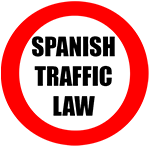1. Any driver who notices that they are being followed for the purpose of being overtaken will be obliged to stick to the right side of the road, except in the cases of turns or changes of direction on the left or stopping on that same side referred to in article 82.2, in which case they should stick to the left as much as possible, but without interfering with the movement of vehicles that may move in the opposite direction (article 35.1 of the articulated text).
Stick to the right edge of the road; This is something that drivers do not usually do, either because of ignorance of the rule or because of neglect, but this rule is still in force.
In the event that it is not possible to completely adhere to the right edge of the road and overtaking can still be done safely, the driver of any of the vehicles referred to in paragraph 3 that will be overtaken will indicate the possibility of doing so to the vehicle that is approaching by extending their arm horizontally and moving it repeatedly backward and forward, with the back of the hand backward, or putting on the right flasher, when it is not convenient to make the signal with their arm.


Use of the right indicator or moving the arm forward and backward; this usually is needed when we want to overtake large vehicles on single lane roads in each direction and due to the dimensions of these, we cannot see well if traffic is coming so we do not go.
In these cases, the driver of the heavy vehicle can make use of the right indicator or move their arm not to indicate an intention to leave the road, but to inform the driver of the vehicle behind that it is possible to overtake safely since there are no oncoming vehicles.
2. The driver of the vehicle to be overtaken is prohibited from increasing their speed or performing manoeuvres that prevent or hinder overtaking.
If you drive on a main road and you see that you are going to be overtaken, you are not allowed to increase your speed, making it difficult to overtake. As much as possible, you should ease the access of the vehicles that are overtaking into the road on which we are driving.
They will also be obliged to reduce the speed of their vehicle when, once the overtaking manoeuvre has begun, there is a situation that entails danger to their own vehicle, to the vehicle that is overtaking, to those travelling in the opposite direction or to any other user of the road (article 35.2 of the articulated text).
Notwithstanding the conditions of the previous paragraph, when the vehicle who wishes to overtake gives explicit signs of desisting from the manoeuvre by reducing their speed, the driver of the vehicle that was intended to be overtaken will not be obliged to reduce speed, if this endangers the safety of traffic, although they will be obliged to facilitate the driver who wants to overtake to return to their lane.
3. Drivers of heavy vehicles of large dimensions or vehicles that are obliged to follow a specific speed limit must either slow down or leave to the hard shoulder as soon as they can. This must be done if it is practical to make way for those who are behind them, when the density of the traffic in the opposite direction, the insufficient width of the road, its profile or state do not allow overtaking easily and without danger.
4. Infringements of the rules of these requirements will be considered a serious matter, as provided in article 65.4.c) of the articulated text. Note that the reference to article 65.4.c) must be understood made to article 65.4.a), as established in the third final provision of this Regulation, introduced by section ten of the single article of the R.D. 965/2006,from September 1, which modifies the General Circulation Regulations, approved by R.D. 1428/2003, of November 21 (“B.O.E.” September 5).
